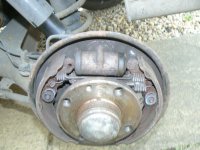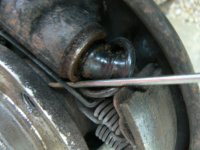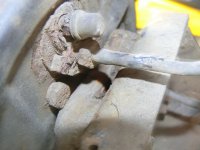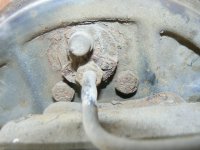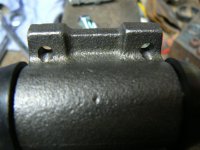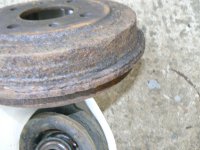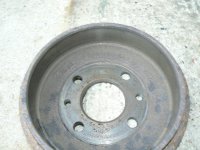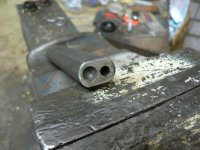Replying to several of above posts.
chris3224 and Charlie. Regarding the idea of fitting the cylinder "upside down" You're right Charlie, the bolts would then be located right on that pressed rim but worse than that, if you turn it upside down the bleed nipple will now be at the bottom - and the drilling which allows fluid to exit via this nipple breaks into the cylinder at the top (with the cylinder mounted in it's normal position) - which will make bleeding very difficult. You can see the "bump" in the casting which accommodates this drilling in the first of the pics I posted earlier. Here is one of the new cylinders I've got waiting to go on and you can see the "bump" on it too:
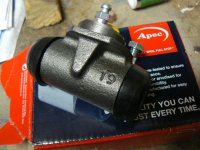
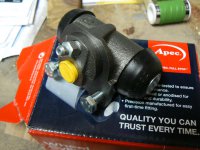
Of course it would have been better if the bolts had been at the top in the first place but it is what it is and probably easier just to work with it as it is. I remember (and I think I've said this before so humour me if you will) but this sort of question was one frequently asked of me when I was a trainer in light vehicle repair and maintenance. Trainees would often ask "Why did they make it this way" when struggling with an inaccessible or awkward component/fixing. The only reply I could find was " well there's nothing we can do about it. They've made it that way, we just have to find out how to fix it".
By the way, can I just suggest that, especially with new drum brake wheel cylinders, you pop a piston out and have a look down the bore for imperfections. Then, if OK, carefully pop the piston back in (to avoid damage to the seal). I can think of two occasions, admittedly many years ago now, where there were casting imperfections (one exacerbated by poor machining) which caused the cylinders to leak and ruin the new linings. It's a task which takes less than a minute when you remove the cylinder from it's packaging but is a real pain if it happens to you. Mind you, I haven't had a problem one for many years now so quality control is obviously much better now - I still wouldn't use one without checking first though. Never had a problem like this with a new caliper.
rmjbn1. Getting drums off when they have a big wear lip is an absolute pain isn't it. In the "good old days" - cue violins - when I first started, working on stuff like Minis, Austin Cambridges, Ford Anglias, etc, etc, they had drums all round and they were manually adjusted at every service (the improvement in pedal "feel" could be dramatic on a vehicle which covered high mileages) Our workshop always removed drums, blew out the dust - why don't I have emphysema/lung cancer? - and lubed these adjusters. we would also deal with any wear lip before it became problematic. Now a days, with disc brakes on the front (inherently self adjusting) and self adjusters on rear drums, many manufacturers do not seem to specify more than a visual inspection of the brakes at service time. They would only receive intervention if friction material was worn out. So, with drums, as the drum itself wears, the lip gets deeper and deeper and and the shoe self adjusts out to follow it. In the end you have a drum which won't come off over the lining even with the handbrake cables disconnected. Sometimes you can "trip" a self adjuster through a wheel retaining bolt hole but if you've got a car with studs you can't even hope for that solution. I find that, after fully backing off the hand brake/removing cables and removing the wheel and drum retaining screw/s, if you put two wheel bolts back into the hub and use a long screwdriver/tyre iron/etc to rotate the drum then another screwdriver, or similar, to prise between the drum rim and backplate whilst rotating the drum, you can often "walk" the drum over the linings - but be careful not to permanently distort the backplate. Often the drum will come "half off" and jam. In this case hitting it - quite hard - with a leather or plastic faced hammer on the side of the drum often works. If it still won't shift sometimes you can get at the shoe retainers through a wheel bolt hole and rotate it with a short length of small dia pipe through the hole until it disengages. Then you can drag the shoes away from the backplate by enough to release the drum. If all else fails due to the lip being so deep, it's likely the drum is worn to it's max dia anyway so just enjoy yourself with a very big hammer (2 lb ball pein works well I find) and break the drum up. It can be very therapeutic after, possibly, several hours of frustrating toil!
Brakes on "Family fleet" vehicles get dismantled, cleaned up and lubed (Copa slip/Cara Tec) every year at service time - even if it's only a lube service - and I rarely have any problems. I also always look under the dust rubbers and depress the pistons on the drum brakes back into the cylinders to make sure they are "free". I'm slightly undecided about pressing caliper pistons fully home at every service as they displace a much larger volume of fluid (so if you do it watch the reservoir doesn't overflow) which carries a larger risk of transferring foreign bodies into the ABS unit. Especially on older cars where the inside of the flex hoses are likely to be degrading a little. I tend now to do it on calipers where I can loosen the bleed nipple so fluid doesn't return (remember to top up when finished) and leave them alone if the nipple looks like shearing. Although I have great hopes for this with my new Vibro tool.
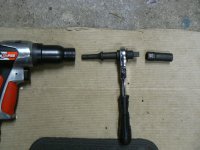
Here's my wee grinding stone which I use in my oldest drill to grind down lips on drums - I think it came off a valve refacing machine:
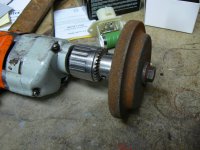
Sorry if I'm telling you guys how to "suck eggs" but remember to ALWAYS pump the brake pedal to "set" the brakes BEFORE trying to move the vehicle. This will pump caliper pistons out to press the pads to the disk rotors - can take maybe half a dozen pumps - and set up self adjusters on rear brakes.
Those of you with "eagle eyes" may notice the new radiator fan resistor pack which I've just noticed has crept into the last picture, It's the green thing in the top of the picture. Oh, it's in the cylinder pics too. This has just arrived and was an eBay bargain (£11.00 approx) to replace the thoroughly knackered one on my boy's Punto:
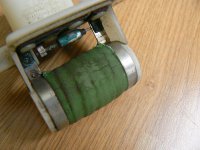
The genuine article is about 4 times the price. even S4p are more than twice that. Hmmm. Wise buy? Oh well, done now.
Stay safe everyone and thank you, thank you, thank you to anyone working in the NHS and other services to keep us safe.


